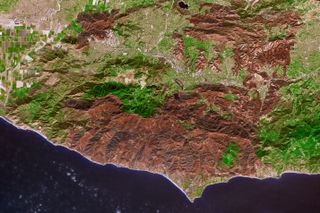NASA's Radar Expertise Is Helping California's Woolsey Fire Recovery
The Woolsey Fire that ravaged Southern California this month is mostly contained — but that doesn't mean the crisis is over.
And to help emergency personnel in the wake of the blaze, NASA has sent an airplane-based radar system to the region to help map damage and look out for ongoing threats, particularly from landslides, which can be devastating in the wake of a burn. A new video released by NASA shows how the process works.
The instrument, called an Uninhabited Aerial Vehicle Synthetic Aperture Radar, studies the surface of the Earth by bouncing beams of light off that surface and timing how long photons take to return. And NASA is used to flying the instrument over Southern California to look for earthquake damage, so the team has data from previous flights, which occurred before the fire broke out, and has well-established flight paths for the instrument to travel. [Satellite Photos of the 2018 California Wildfires]

So, as the fire burned, NASA personnel realized the potential of the radar program to map the blaze's damage. They reshuffled the instrument's schedule and had it ready for a flight over Southern California on Nov. 15, gathering data over 150 square miles (240 square kilometers).
Now, emergency personnel can use that data to identify areas particularly affected by the blaze. One of the most concerning threats in a fire's aftermath comes from landslides, because a fire burns away the vegetation anchoring soil in place. With winter rains due to start soon, responders are targeting steeper slopes where the radar data shows signs that vegetation has burned.
And while fires themselves are a terrifying sight, landslides can actually be more deadly. Landslides after last year's Thomas Fire, located just a bit west of the Woolsey blaze, killed more people than the initial burn did.
Email Meghan Bartels at mbartels@space.com or follow her @meghanbartels. Follow us @Spacedotcom and Facebook. Original article on Space.com.
Get the Space.com Newsletter
Breaking space news, the latest updates on rocket launches, skywatching events and more!
Join our Space Forums to keep talking space on the latest missions, night sky and more! And if you have a news tip, correction or comment, let us know at: community@space.com.

Meghan is a senior writer at Space.com and has more than five years' experience as a science journalist based in New York City. She joined Space.com in July 2018, with previous writing published in outlets including Newsweek and Audubon. Meghan earned an MA in science journalism from New York University and a BA in classics from Georgetown University, and in her free time she enjoys reading and visiting museums. Follow her on Twitter at @meghanbartels.











